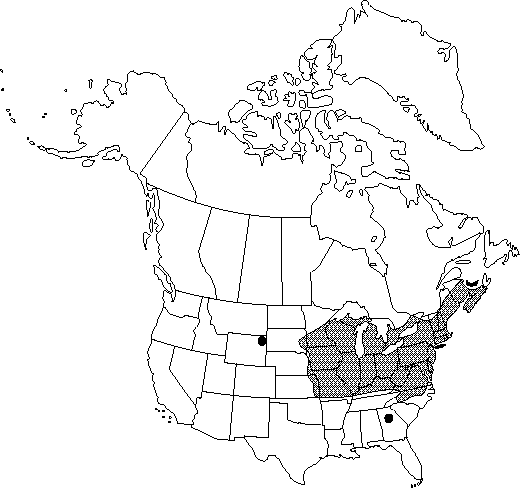Difference between revisions of "Berberis thunbergii"
Syst. Nat. 2: 19. 1821.
FNA>Volume Importer |
imported>Volume Importer |
||
| (7 intermediate revisions by 2 users not shown) | |||
| Line 9: | Line 9: | ||
|common_names=Japanese barberry | |common_names=Japanese barberry | ||
|special_status={{Treatment/ID/Special_status | |special_status={{Treatment/ID/Special_status | ||
| − | |code= | + | |code=W2 |
| − | |label= | + | |label= |
}}{{Treatment/ID/Special_status | }}{{Treatment/ID/Special_status | ||
|code=I | |code=I | ||
| Line 24: | Line 24: | ||
}}<!-- | }}<!-- | ||
| − | --><span class="statement" id="st- | + | --><span class="statement" id="st-undefined" data-properties=""><b>Shrubs,</b> deciduous, 0.3-3 m. <b>Stems</b> dimorphic, with short axillary shoots. <b>Bark</b> of 2d-year stems purple or brown, glabrous. <b>Bud</b> scales 1-2 mm, deciduous. <b>Spines</b> present, simple or 3-fid. <b>Leaves</b> simple; petioles 0-0.8 cm. <b>Leaf</b> blade obovate to spatulate, 1-veined from base, (0.5-)1.2-2.4 × 0.3-1(-1.8) cm, thin and flexible, base long-attenuate, margins plane, entire, apex rounded or obtuse; surfaces abaxially dull, smooth, adaxially dull, scarcely glaucous. <b>Inflorescences</b> umbellate, 1-5-flowered, 1-1.5 cm; bracteoles membranous, apex acute. <b>Flowers</b>: anther filaments without distal pair of recurved lateral teeth. <b>Berries</b> red, ellipsoid or spheric, (7-)9-10 mm, juicy, solid.</span><!-- |
-->{{Treatment/Body | -->{{Treatment/Body | ||
| Line 30: | Line 30: | ||
|habitat=Woods, old fields, roadsides | |habitat=Woods, old fields, roadsides | ||
|elevation=0-1300 m | |elevation=0-1300 m | ||
| − | |distribution=N.B.;N.S.;Ont.;P.E.I.;Conn.;Del.;Ga.;Ill.;Ind.;Iowa;Kans.;Ky.;Maine;Md.;Mass.;Mich.;Minn.;Mo.;Nebr.;N.H.;N.J.;N.Y.;N.C.;Ohio;Pa.;S.Dak.;Vt.;Va.;W.Va.;Wis.;Wyo.;native;Asia (Japan) | + | |distribution=N.B.;N.S.;Ont.;P.E.I.;Conn.;Del.;Ga.;Ill.;Ind.;Iowa;Kans.;Ky.;Maine;Md.;Mass.;Mich.;Minn.;Mo.;Nebr.;N.H.;N.J.;N.Y.;N.C.;Ohio;Pa.;S.Dak.;Vt.;Va.;W.Va.;Wis.;Wyo.;native;Asia (Japan). |
| − | |discussion=<p>The U.S. Department of Agriculture lists Berberis thunbergii as resistant to infection by Puccinia graminis, and the species is widely grown as an ornamental in the United States. Preliminary tests carried out by Agriculture Canada, however, suggest that some strains may be susceptible to Puccinia graminis infection, and cultivation of B. thunbergii is illegal in Canada.</p> | + | |introduced=true |
| + | |discussion=<p>The U.S. Department of Agriculture lists <i>Berberis thunbergii</i> as resistant to infection by Puccinia graminis, and the species is widely grown as an ornamental in the United States. Preliminary tests carried out by Agriculture Canada, however, suggest that some strains may be susceptible to Puccinia graminis infection, and cultivation of <i>B. thunbergii</i> is illegal in Canada.</p> | ||
|tables= | |tables= | ||
|references= | |references= | ||
| Line 40: | Line 41: | ||
-->{{#Taxon: | -->{{#Taxon: | ||
name=Berberis thunbergii | name=Berberis thunbergii | ||
| − | |||
|authority=de Candolle | |authority=de Candolle | ||
|rank=species | |rank=species | ||
| Line 50: | Line 50: | ||
|habitat=Woods, old fields, roadsides | |habitat=Woods, old fields, roadsides | ||
|elevation=0-1300 m | |elevation=0-1300 m | ||
| − | |distribution=N.B.;N.S.;Ont.;P.E.I.;Conn.;Del.;Ga.;Ill.;Ind.;Iowa;Kans.;Ky.;Maine;Md.;Mass.;Mich.;Minn.;Mo.;Nebr.;N.H.;N.J.;N.Y.;N.C.;Ohio;Pa.;S.Dak.;Vt.;Va.;W.Va.;Wis.;Wyo.;native;Asia (Japan) | + | |distribution=N.B.;N.S.;Ont.;P.E.I.;Conn.;Del.;Ga.;Ill.;Ind.;Iowa;Kans.;Ky.;Maine;Md.;Mass.;Mich.;Minn.;Mo.;Nebr.;N.H.;N.J.;N.Y.;N.C.;Ohio;Pa.;S.Dak.;Vt.;Va.;W.Va.;Wis.;Wyo.;native;Asia (Japan). |
|introduced=true | |introduced=true | ||
|reference=None | |reference=None | ||
|publication title=Syst. Nat. | |publication title=Syst. Nat. | ||
|publication year=1821 | |publication year=1821 | ||
| − | |special status= | + | |special status=W2;Introduced |
| − | |source xml=https:// | + | |source xml=https://bitbucket.org/aafc-mbb/fna-data-curation/src/2e0870ddd59836b60bcf96646a41e87ea5a5943a/coarse_grained_fna_xml/V3/V3_815.xml |
|genus=Berberis | |genus=Berberis | ||
|species=Berberis thunbergii | |species=Berberis thunbergii | ||
| − | |||
| − | |||
| − | |||
| − | |||
| − | |||
| − | |||
| − | |||
| − | |||
| − | |||
| − | |||
| − | |||
| − | |||
| − | |||
| − | |||
| − | |||
| − | |||
| − | |||
| − | |||
| − | |||
| − | |||
| − | |||
| − | |||
| − | |||
| − | |||
| − | |||
| − | |||
| − | |||
| − | |||
| − | |||
| − | |||
| − | |||
| − | |||
| − | |||
| − | |||
| − | |||
| − | |||
| − | |||
| − | |||
}}<!-- | }}<!-- | ||
-->[[Category:Treatment]][[Category:Berberis]] | -->[[Category:Treatment]][[Category:Berberis]] | ||
Latest revision as of 21:51, 5 November 2020
Shrubs, deciduous, 0.3-3 m. Stems dimorphic, with short axillary shoots. Bark of 2d-year stems purple or brown, glabrous. Bud scales 1-2 mm, deciduous. Spines present, simple or 3-fid. Leaves simple; petioles 0-0.8 cm. Leaf blade obovate to spatulate, 1-veined from base, (0.5-)1.2-2.4 × 0.3-1(-1.8) cm, thin and flexible, base long-attenuate, margins plane, entire, apex rounded or obtuse; surfaces abaxially dull, smooth, adaxially dull, scarcely glaucous. Inflorescences umbellate, 1-5-flowered, 1-1.5 cm; bracteoles membranous, apex acute. Flowers: anther filaments without distal pair of recurved lateral teeth. Berries red, ellipsoid or spheric, (7-)9-10 mm, juicy, solid.
Phenology: Flowering late winter–spring (Mar–May).
Habitat: Woods, old fields, roadsides
Elevation: 0-1300 m
Distribution

Introduced; N.B., N.S., Ont., P.E.I., Conn., Del., Ga., Ill., Ind., Iowa, Kans., Ky., Maine, Md., Mass., Mich., Minn., Mo., Nebr., N.H., N.J., N.Y., N.C., Ohio, Pa., S.Dak., Vt., Va., W.Va., Wis., Wyo., native, Asia (Japan).
Discussion
The U.S. Department of Agriculture lists Berberis thunbergii as resistant to infection by Puccinia graminis, and the species is widely grown as an ornamental in the United States. Preliminary tests carried out by Agriculture Canada, however, suggest that some strains may be susceptible to Puccinia graminis infection, and cultivation of B. thunbergii is illegal in Canada.
Selected References
None.